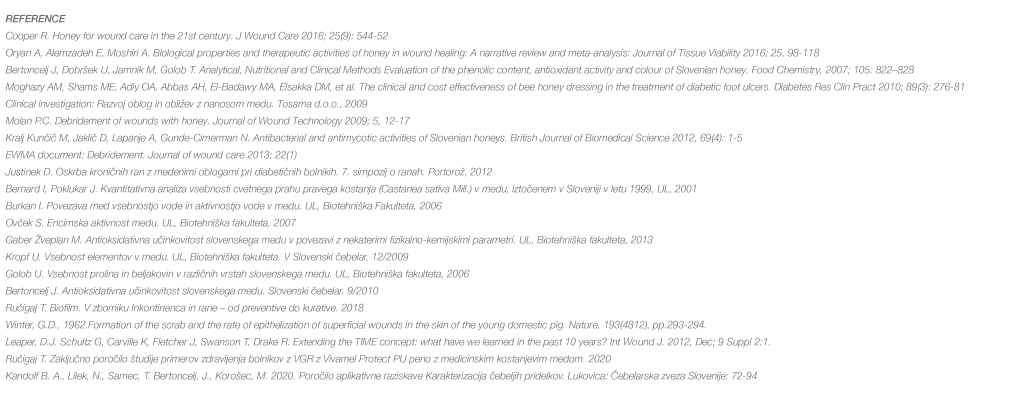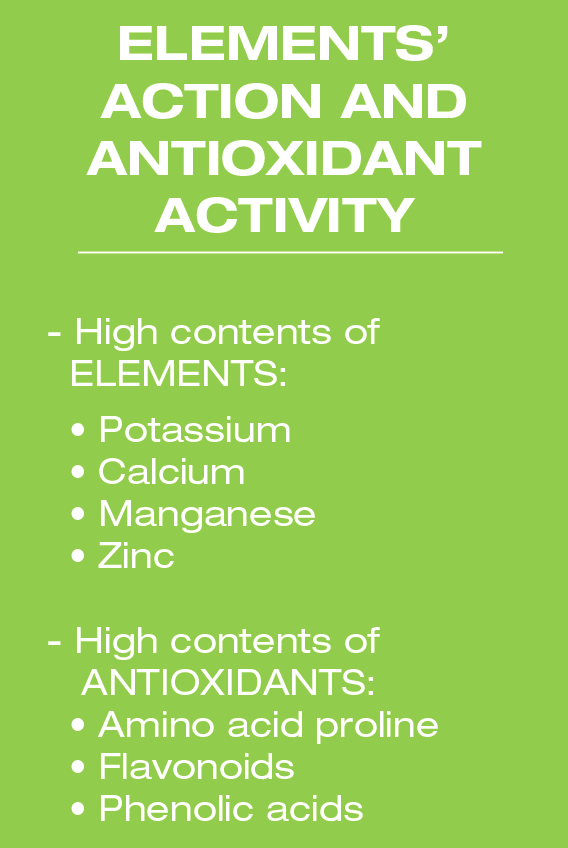MEDICAL CHESTNUT
HONEY
Provides exceptional effects
throughout the wound healing process.
Specific properties of chestnut honey provide a complex mechanism of various effects in the wound healing process.
MEDICAL CHESTNUT HONEY:
• is a saturated solution of sugars that causes osmotic pressure in the wound, which stimulates autolytic debridement (Cooper, 2016; Oryan, 2016),
• has an acidic pH, which promotes wound healing, inhibits microbial growth, and maintains an adequate number of MMPs (Oryan, 2016),
• has light levels of the enzyme glucose oxidase, which activates proteolytic debridement and contributes to antimicrobial and anti-inflammatory action (Kralj Kunčič et al., 2012; Cooper, 2016),
• contains a striking amount of kynurenic acid, which destabilizes and prevents the formation of biofilm (Cooper, 2016),
• has high contents of potassium, manganese, zinc, calcium, and the amino acid proline, which promote granulation and epithelialization (Oryan, 2016),
• has high contents of phenolic acids and flavonoids, which have antioxidant capacities (Bertoncelj et al., 2007),
• is 100% natural, additive free.
MAIN MECHANISMS OF ACTION OF MEDICAL CHESTNUT HONEY

IDEAL RATIO OF SUGARS
Honey is a saturated solution of sugars (up to 80%), simple and complex ones. Sugar uses the osmotic principle to dehydrate bacteria and simultaneously triggers a local immune response in the wound. Osmotic pull of fluids from the tissues activates autolytic debridement, so the necrotic tissue in the wound softens and is easier to detach.
Most of the sugars are a mixture of two monosaccharides: fructose and glucose. The ratio between the two depends largely on botanical origin and is specific to each type of honey. Chestnut honey, which is made from nectar and manna, has a specific ratio of the two main types of sugars: on average, 42% of fructose and 25% of glucose. The ratio of the two sugars in chestnut honey determines its viscosity. Due to its optimal viscosity, chestnut honey is easily pourable and comes into contact with the entire surface of the of the wound bed (guaranteed good contact of the dressing with the wound). Therefore, it is able to remove impurities and foreign matter from the wound.
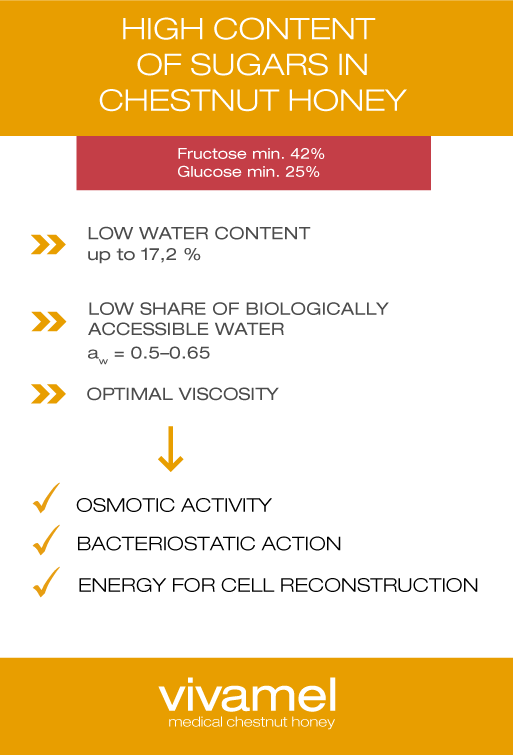
Honey with a high content of sugars has a low water content and is ideal for wound healing. The water content determines the physicochemical parameters of honey. The lower the water content in honey, the greater its durability and quality.
Another important parameter is also the availability of free, unbound water in honey compounds. This free, unbound water is called water activity (aw), which ranges between 0.5 and 0.65 in chestnut honey. An environment with such low water activity is hostile to microorganisms (for reproduction they need aw = 0.94–0.99).
“The microbes in the wound feed on exudate. The sugars in honey divert microbes to start feeding on glucose from honey instead of protein from the exudate. As a product of metabolism, lactic acid is formed, which does not have the odour and further lowers the pH in the wound, thus maintaining an environment that is not favourable to microbes.”
When medical chestnut honey is applied to the wound, its high sugar content causes osmotic pressure, which is based on the pull of water from the area of lower sugar concentration to the area of higher sugar concentration (pulling fluid from the tissue). The level of osmotic activity depends on the physical properties of honey (content and ratio of sugars, water content) and the amount of wound exudate.
OSMOTIC ACTIVITY IN THE WOUND:
- creates a moist environment, i.e., optimal healing conditions;
- stimulates perfusion in the tissue, which activates autolytic debridement that ensures a faster course of the inflammatory phase, reduces inflammation and oedema, the wound heals faster;
- triggers a local immune response: Osmosis massively attracts macrophages and lymphocytes, which provide phagocytosis. The pull of liquids into honey activates glucose oxidase that catalyses a chemical reaction in which hydrogen peroxide (H2O2) and gluconic acid are released slowly and in low concentrations. H2O2 activates proteases in the wound and promotes proteolytic debridement and gluconic acid further lowers the pH in the wound;
- maintains the appropriate level of growth factors, accelerates collagen synthesis in the granulation phase, and stimulates smooth proliferation and migration of keratinocytes during the epithelialization phase.

ACIDIC pH
Chronic wounds that do not heal well typically have an alkaline pH above 7.3. The healing process is triggered only when the environment in the wound is acidic, with a pH level below 7. Medical chestnut honey creates an acidic environment in the wound that triggers the healing process, prevents bacterial growth, and regulates the level of matrix metalloproteinases (MMPs).
In addition to low water content and low bioavailable water content, honey’s pH is also important for wound healing. Medical chestnut honey has an acidic pH that varies between 3.5 and 6, depending on the content of various organic acids, which give honey its characteristic taste and aroma and contribute to its stability. The ratio of acids determines mainly antibacterial and antioxidant activity and regulates the activity of matrix metalloproteinases (MMPs).
Medical chestnut honey helps lower pH in the wound due to:
- total content of acids determining honey’s acidity;
- gluconic acid that is present in high quantities and is also formed in a chemical reaction triggered by the enzyme glucose oxidase, which additionally lowers the pH in the wound (peroxide mechanism);
- lactic acid that is formed as a product of bacterial metabolism and additionally lowers the pH in the wound.
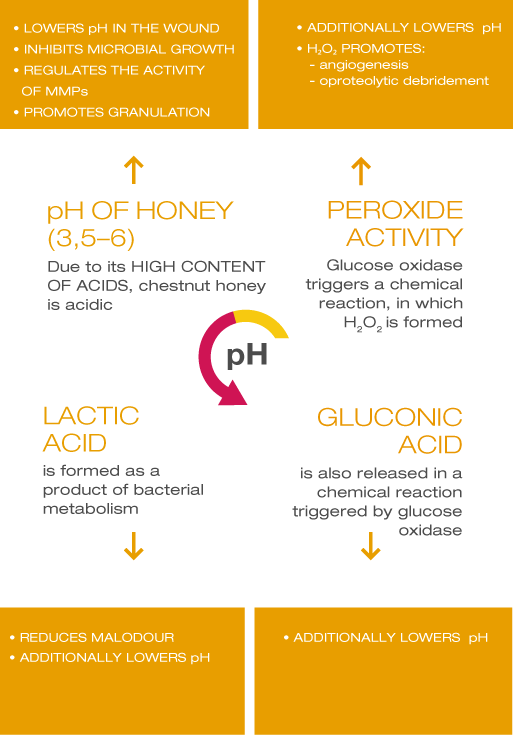
KYNURENIC ACID
Biofilm is present in most chronic wounds. It is a cluster of slow-growing bacterial cells that form a persistent polysaccharide protective coat. Chestnut honey is the only type of honey that contains kynurenic acid, which prevents the formation of biofilm or destabilizes it.
Chestnut honey has an exceptionally high content of kynurenic acid, which has the ability to destabilize and prevent the formation of biofilm. Analysis of different types of honey showed that chestnut honey stands out in terms of kynurenic acid content, reaching an average value between 305 and 601 μg/g, while the average content in other types of honey is between 0.093 and 14.2 μg/g.
Kynurenic acid affects quorum sensing (QS) – the communication system of the bacteria. Bacteria use QS molecules to communicate with each other, using special signals; communication is a key process, particularly in biofilm formation and the defence against external influences, antibiotics, and host’s immune response. When communication among bacteria is interrupted, medical chestnut honey in the wound displays a high antimicrobial potential with a long-lasting and intense effect. It is based on physicochemical properties of honey (high sugar content, low water content, and acidic pH), the non-peroxide inhibin system (peptides, flavonoids and phenolic acids, and cationic and non-cationic bactericidal components), and peroxide microbial inhibition (based on the enzyme glucose oxidase).

GLUCOSE OXIDASE
Medical chestnut honey contains glucose oxidase, an enzyme that is activated when honey is diluted. It triggers a reaction, in which gluconic acid and hydrogen peroxide are formed. As a result, the pH in the wound lowers additionally and proteases are activated, stimulating proteolytic debridement.
In wound treatment, two enzymes secreted into honey by the bees have had strong positive effects:
- defensin-1 (also known as royalisin), an antimicrobial peptide (AMP) that is the primary defence system of most organisms. The enzyme is an important factor in the non-peroxide antimicrobial mechanism of honey; it affects Gram-positive and Gram-negative bacteria and viruses;
- glucose oxidase (GO) that is secreted into the nectar by the bees’ hypopharyngeal gland. Water is required for glucose oxidation, therefore, during the maturation of honey, the activity of the enzyme in the nectar gradually decreases due to the increase in the concentration of sugars (and decrease in water) and then stops in mature honey. The enzyme becomes active when honey in the wound is diluted with secretions.

HIGH CONTENTS OF ELEMENTS
Compared to other types of honey, chestnut honey stands out due to its high contents of potassium, calcium, manganese, and zinc. These elements are involved in the synthesis of collagen, which is a building block of newly formed tissue. Consequently, the processes of granulation and epithelialization in the wound are accelerated.
Types of honey are very diverse in terms of the contents of different elements – the content of elements depends on honey’s botanical and geographical origin. Chestnut honey is made from nectar and manna. Manna honey contains more elements than nectar honey. In terms of high contents of elements, chestnut honey stands out distinctly. It is a forest honey free of heavy metals with high contents of potassium, calcium, manganese, and zinc – elements that are crucial in the synthesis of collagen and extracellular matrix. The synthesis is also supported by the physical properties of chestnut honey. It creates a favourable moist environment in the wound, which shortens the inflammatory phase and ensuress uninterrupted proliferation and migration of cells and thus uninterrupted granulation and epithelialization. Consequently, wound healing is accelerated and results in less or no scars.
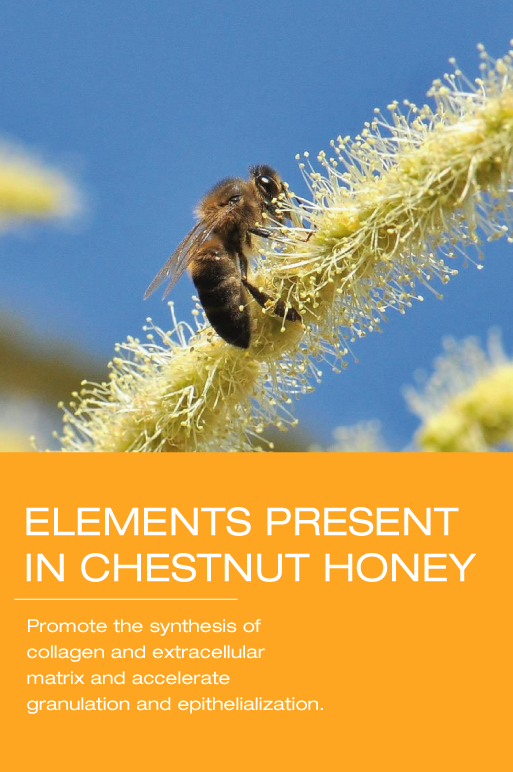
AMINO ACID PROLINE
One of the main indicators of chestnut honey’s authenticity is a high content of the amino acid proline. In the wound, proline acts as a potent antioxidant and is crucial in collagen synthesis.
18 amino acids have been identified in honey, with proline representing the biggest share. The content of amino acids varies greatly between different types of honey and averages from 100 to 400 mg/kg. Darker honey contains more amino acids than lighter. The criterion for the total content of amino acids is the content of proline. The proline content is used to determine the quality of honey and its maturity. Honey must contain at least 180 mg/kg of proline; if there is less of it, the honey is probably fake. PROLINE, the predominant amino acid in honey (up to 85% of all amino acids in honey), is an antioxidant with an extremely high capacity to remove free radicals.
Proline in honey is made from pollen, nectar, and manna. It has been proven that the content of proline depends on the metabolism of insects, namely lice and scale insects that feed on tree sap and excrete manna, which is then collected by bees.
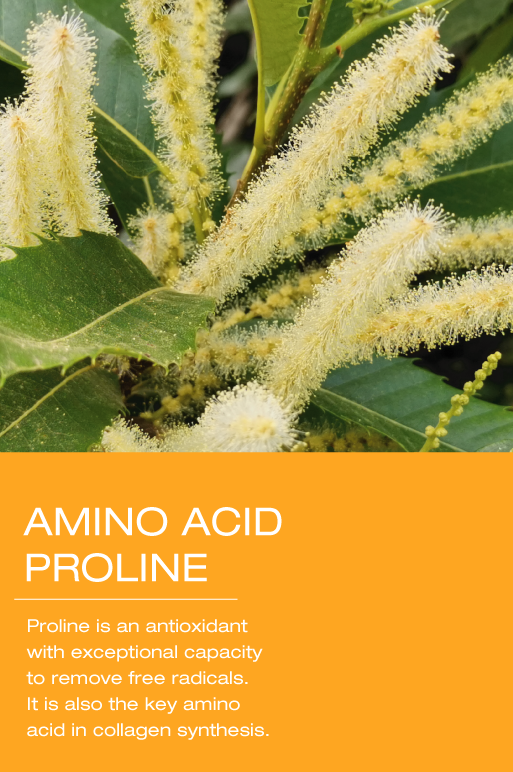
ANTIOXIDANTS
Chestnut honey is rich in antioxidants, mainly in flavonoids and phenolic acids, as well as ascorbic acid and proline. Antioxidant activity and, by extent, anti-inflammatory action are based on the inhibition of free radicals. An oxidative balance is established in the tissue, which shortens the inflammatory phase and promotes wound healing.
Antioxidants are substances that can prevent and inhibit unwanted oxidative changes in food and living organisms even in small concentrations, therefore, they are also called free radical scavengers. They protect cells in the human body from free radicals that cause oxidation, thus preventing oxidative stress. Sweet chestnut synthesizes compounds with antioxidative efficacy. Bees collect nectar or manna and thus transfer bioactive ingredients to chestnut honey, which puts it among potent natural antioxidants.
The antioxidative potential of honey is a result of the combined activity of amino acids (especially proline), phenolic compounds (phenolic acids and flavonoids), and ascorbic acid (vitamin C). These natural tailors of biological responses in the wound have also demonstrated proven antimicrobial and anti-inflammatory activity.

100% NATURAL
ORIGIN

Pure, naturally produced SWEET CHESTNUT (Castanea sativa) honey in one of the purest types of honey with exceptional composition. This forest honey is made from nectar and manna, therefore, it is a specific complex solution of sugars, amino acids, enzymes, vitamins, minerals, acids, and flavonoids that demonstrate important effects in the wound healing process.
It is produced under controlled conditions (HACCP) and subjected to microbiological and biochemical analyses. The production of wound dressings takes place in a highly controlled environment (clean room), the dressings are sterilized by e-beam sterilization.
Medical chestnut honey is characterized by complex mechanisms that promote wound healing; they depend on the plant on which the bee forages, the enzymes secreted by the bee in the honey, and the physicochemical properties of the honey.
Naturally produces chestnut honey, the active ingredient in Vivamel wound dressings:
- is entirely produced by bees,
- does not contain synthetic and genetically modified components,
- is made from nectar and manna, so it stands out in terms of the content of elements and amino acids,
- is one of the purest types of honey in terms of pollen content,
- is undiluted, without added thickeners and other additives.
For the production of Vivamel dressings with medical chestnut honey, exclusively naturally produced chestnut honey in 100% concentration without added thickening agents is used. Honey is processed according to different standards so that the dressings are completely safe for the user: controlled production according to HACCP, transport and storage of honey, biochemical and microbiological analyses, biocompatibility tests, production of medical honey coatings under controlled conditions (clean room), and an appropriate sterilization process (e-beam) that destroys microbes, including sporogenic bacteria.
